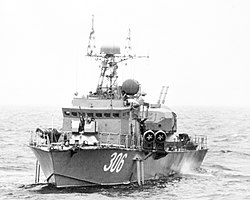This article needs additional citations for verification .(February 2013) |
 A Project 206M "Shtorm" (NATO - Turya class) patrol fast attack craft hydrofoil of the Cuban Navy | |
| Class overview | |
|---|---|
| Name | Turya class (Project 206M) |
| Operators | see below |
| Preceded by | Shershen class |
| Built | 1972-1976 |
| In service | 1972- present day |
| Completed | 51? |
| General characteristics | |
| Type | hydrofoil torpedo boat |
| Displacement | 220 tons standard, 250 tons full load |
| Length | 39.6 m |
| Beam | 7.6 m |
| Draught | 4 m |
| Propulsion | 3× M503 B2 Diesels; 15,000 hp |
| Speed | 40 knots |
| Range | 600 nm at 37 knots, 1450 nm at 14 knots |
| Crew | 30 |
| Sensors & processing systems | Radar: Pot Drum, Muff Comb, High Pole, Sonar: Foal Tail |
| Armament |
|
"Turya class" is the NATO reporting name for a class of hydrofoil torpedo boats built for the Soviet Navy and Soviet allies. The Soviet designation was Project 206M.

